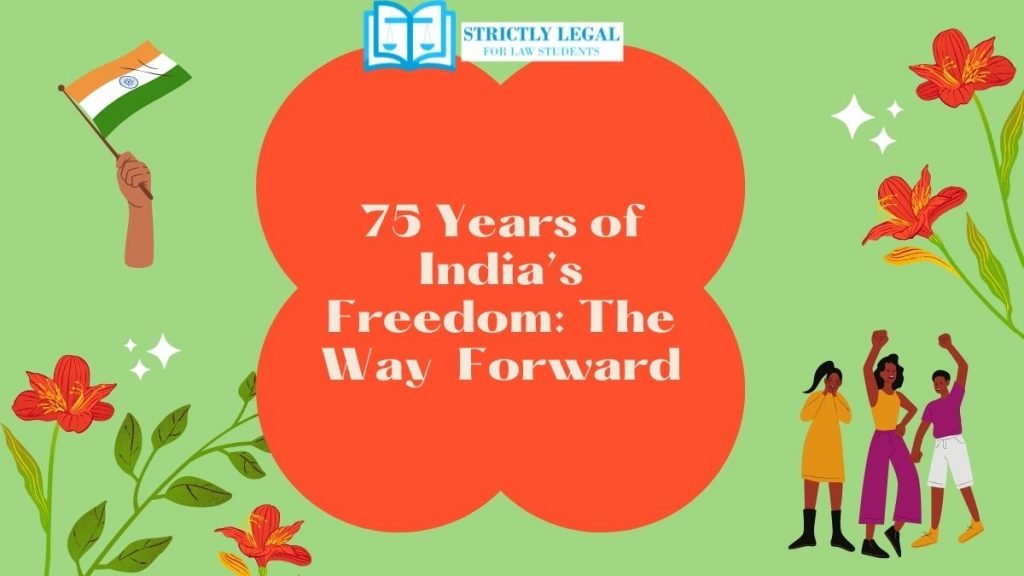India is known to be the world’s largest democracy. It is the only nation in Asia to sustain its democratic rights following its freedom from the British government. The only elision occurred during the Emergency period of 1975-76, and the democratic processes were arrested for the time being.
Democracy in India (Source- “Changing Face of Democracy in India – Analysis – Development News”, 2021)
On August 15, 2021, we are going to complete our 75th year of independence. And, in these 75 years, India has seen dramatic changes in several aspects. While there are many things that India takes pride in, several areas have let India feel down as well (Sullivan, 2014).
Refugees during India’s Partition (Source- “How Partition Shaped the Businesses That Moved Across Borders”, 2021)
During the earliest days of India’s independence, the nation faced different complex and challenging troubles. India was partitioned, causing a considerable number of people to get uprooted. Rehabilitating them was the nation’s fundamental responsibility then (Sullivan, 2014). And while the government was focusing on rehabilitating the refugees, Pakistan attacked India to accede Kashmir back (following partition, Kashmir had become a part of India). In the meanwhile, Razakars in Hyderabad rose up against the Indian Government. Several Maharajas from different territories tried to come up with Independent states. All of these challenging issues were overcome under the guidance of eminent leaders of India like Sardar Patel (Karlekar, 2007).
Independent India’s first and foremost objective was to consolidate several fragments of the nation and assimilate the princely states. The motive behind this assimilation was to unify India and its citizens (Bose, 1998).
26 January 1950 was a momentous day for India, as the nation was announced a ‘Republic.’ The Constituent Assembly of India adopted a new constitution on 26 November 1949 and reinforced it on 26 January 1950 (Bose, 1998). The constitution had some unique and new features that demonstrated a stark contrast with the British colonial rules of the past (Karlekar, 2007). The Indian constitution adopted the Westminster model of democratic government. The Indian polity amalgamated with federal and unitary forms of government (Bose, 1998). The new constitution ensured justice, liberty, equality, and fraternity to all its citizens. It also declared the nation as a secular state, and any act of discrimination against any person based upon religion, caste, creed, or race was a punishable offense.
The Constitution of India Preamble (Source- News, 2021)
The new democratic government also focused on bringing reforms on the socio-economic dimension of India and thus adopted a ‘socialistic pattern of society. Besides the fundamental rights, the constitution also developed special provisions for the laden and oppressed communities. It listed a few castes and tribes in a schedule and denominated them as scheduled castes (SCs) and scheduled tribes (STs). The colonial masters ruled with the policy of “divide and rule” and segmented Indian society along religious lines. The new democratic India discarded those colonial practices ad believed in equality for all (Spipati, 1997).
This was to make sure the containment of communalism. Nevertheless, the history of India’s independence has seen a number of communal riots and the emergence of different political parties into power along religious lines (Spipati, 1997). Strangely enough, the political parties chanting mantras of secularism at times contributed (maybe unintentionally) to the communal riots. With their keen enthusiasm to safeguard the interests of the minority communities, the secular political parties started promoting communal interests, essentially creating vote-banks. As a result, it led to agitation among the majority of communities (Sullivan, 2014).
From the economic perspective, in 1991, the Liberalised Economy policy was brought forward. India was going through a severe economic crisis as agriculture, and industrial growth was stagnant. India’s financial sector remained in a state of inactivity. The nation was under gigantic foreign debt, and a huge financial deficit was coming up (Spipati, 1997). Indian
citizens faced a double-digit rate of inflation. With the new Liberalized policy’s advent, the growth rate went up by 6.8% during the eighth plan. The foreign exchange reserves gradually increased, and inflation gradually fell down (Spipati, 1997).
In terms of science and technology, post-independence, India has made commendable progress in national development by the application of modern science and technology (Bose, 1998). Some areas where India has made noteworthy progress are- healthcare system, water and sewage management, and lastly, nuclear power capacity. Development of the satellite launch vehicles, associated ground system, remote sensing satellites, and GRAM SAT are a few pieces of evidence of India’s advancements in the field of science and technology (Karlekar, 2007).
But the advantages of these technological advancements are way more prominent in some parts of India, and sadly rural India is still quite neglected. Industrial development, advancements in space application, and nuclear research have not yet completely mitigated the rural community’s issues (Sullivan, 2014). A large population of India still dwells in unsanitary conditions, has no access to safe drinking water and healthcare facilities. Even today, several villages in India live in steep poverty, have no electricity, no schools, and no easy ways of communication.
Rural poverty In India (Source- Changing Face of Democracy in India – Analysis – Development News”, 2021)
When it comes to diplomatic aspects, India has always been very sincere about its commitments. Since independence, India has supported and worked for a nuclear-weapon-free world. India always participates in fair treaties to fortify its defence, like the chemical weapons convention (Sullivan, 2014).However, unfortunately, there have been massive drawbacks to what it has achieved in the last few decades. India’s greatest failure to date has been failing to eradicate corruption at different levels of government. India ranks in 7th position in the list of most corrupted countries in the world. Corruption is a bigger threat than an invasion from other countries. Another fallacy is the slow economic growth of the country (Karlekar, 2007). Even today, 30% of India’s population is grounded by extreme poverty; thus, affecting the overall progress and development of society. Poverty constricts the domestic market’s size and causes hindrance in the nation’s economic growth prospects, much like inadequate physical infrastructures (Sullivan, 2014).
Child Labour in India (Source- Changing Face of Democracy in India – Analysis – Development News
The education scenario of India is also grim. Around 105 million Indian children in the age group of 6-10 years do not go to school. Even the government has come up with various schemes and programs to reinforce education for all, and there isn’t a lot of improvement. And this issue is directly associated with child labour (Bose, 1998). In India, child labour is a substantial problem distorting the nation’s economic growth process. Some of the major reasons for child labour in India are poverty, lack of education, wage structure, and massive backlog in creating new job opportunities. According to the reports, India has a backlog of 9 million job backlogs, which were supposed to be created in the last decade and a half (Karlekar, 2007).
To eliminate the menaces from Indian society, we require joint efforts. There should make a massive shift in the attitude among employers (Bose, 1998). The health and welfare executives must put efforts into encouraging and implement family norms, particularly in the rural and under-developed regions of India. Also, there should be a significant improvement in the working environment and economic conditions of the adult employees (Spipati, 1997).Keeping in mind all the challenges India faces in the last few decades, today, the nation is craving for growth and change like never before. According to the reports, nearly 65% of India’s population is below the age of 35. This makes India one of the youngest and dynamic nations in the world (Mitra, 2021). As an aspirational nation that is also digitally enabled, India is looking forward to nurturing its skills and finding new growth and development opportunities. Thus, India’s present government has come up with a comprehensive strategy at the national level, defining lucid objectives for the nation as it celebrates 75 years of independence. The strategy has covered 41 crucial aspects of India.
Narendra Modi (Source- News, 2021)
Prime Minister Narendra Modi has explained this complicated exercise in a simpler way. According to him, “The Strategy for New India @75, put together by NITI Aayog, is an attempt to bring innovation, technology, enterprise and efficient management together, at the core of policy formulation and implementation. It will encourage discussion and debate, and invite feedback for further refining our policy approach. We believe that economic transformation cannot happen without public participation. Development must become a Jan Andolan (public movement) (Mitra, 2021).”
Thus, India, at present, has accepted one of the biggest challenges of the modern era. It looks forward to establishing economic independence through non-violent methods. Corporate India has a crucial role to play in this regard. The main objective is to conquer hunger, unemployment
and eliminate other menaces of Indian society. The true success of democratic India will depend upon the successful implementation of the strategy, as mentioned earlier.
References
• Spipati, V. (1997). Human Rights in India-fifty years after independence. Denv. J. Int’l L. & Pol’y, 26, 93.
• Sullivan, K. (2014). Exceptionalism in Indian diplomacy: The origins of India’s moral leadership aspirations. South Asia: Journal of South Asian Studies, 37(4), 640-655. • Karlekar, H. (2007). 60 Years of India’s Independence and Democracy. Strategic Analysis, 31(6), 985-996.
• Mitra, A. (2021). How India is preparing for life at 75. Retrieved 20 March 2021 • Bose, S. (1998). Nation, Reason and Religion: India’s Independence in International Perspective. Economic and Political Weekly, 2090-2097.
• Changing Face of Democracy in India – Analysis – Development News. (2021). Retrieved 20 March 2021
• News, I. (2021). Reconnect with the Preamble | India News – Times of India. Retrieved 20 March 2021
• How Partition Shaped the Businesses That Moved Across Borders. (2021). Retrieved 20 March 2021
Author: Abhimanyu Mukherjee, KIIT School of Management

Users not registered with Strictlylegal can Email us their content and the same are posted through this account. In case of abuse, kindly let us know at [email protected]





